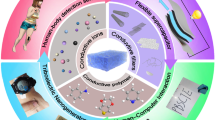Abstract
This study presents a method for the synthesis of copper nanoparticles, which are poised to replace silver nanoparticles in some application areas of printed electronics. This method offers three advantages. Firstly, copper loading in the synthesis reaction can be as high as 1 M, offering high productivity in large-scale production. Secondly, the size of the copper nanoparticles can be controlled from 12 to 99 nm. Thirdly, the surface polarity of the particles can be modified. Thus, a tailor-made product can be synthesized. The synthesis of copper nanoparticles coated with various capping agents, including dodecanethiol, lauric acid, nonanoic acid, polyacrylic acid, and polyvinyl pyrrolidone, was demonstrated. The nonanoic acid-coated copper nanoparticles were formulated as a screen-printing conductive paste. The particles were readily dispersed in terpineol, and the paste could be screen printed onto flexible polyester. The electrical resistivity of patterns after a low-temperature (120 °C) sintering treatment was around 5.8 × 10−5 Ω cm.
Graphical Abstract











Similar content being viewed by others
References
Buffat P, Borel JP (1976) Size effect on the melting temperature of gold particles. Phys Rev A 13(6):2287
Cason JP, Miller ME, Thompson JB, Roberts CB (2001) Solvent effects on copper nanoparticle growth behavior in AOT reverse micelle systems. J Phys Chem B 105(12):2297–2302
Deegan DE, Chapman CD, Johnson TP (2006). Plasma arc reactor for the production of fine powders. U.S. patent 7,727,460 B2. 2005 Dec 16
Deng D, Jin Y, Cheng Y, Qi T, Xiao F (2013) Copper nanoparticles: aqueous phase synthesis and conductive films fabrication at low sintering temperature. ACS Appl Mater Interfaces 5(9):3839–3846
Dhas NA, Raj CP, Gedanken A (1998) Synthesis, characterization, and properties of metallic copper nanoparticles. Chem Mater 10(5):1446–1452
Huang D, Liao F, Molesa S, Redinger D, Subramanian V (2003) Plastic-compatible low resistance printable gold nanoparticle conductors for flexible electronics. J Electrochem Soc 150(7):G412–G417
Kamyshny A, Steinke J, Magdassi S (2011) Metal-based inkjet inks for printed electronics. Open Appl Phys J 4:19–36
Kang JS, Kim HS, Ryu J, Hahn HT, Jang S, Joung JW (2010) Inkjet printed electronics using copper nanoparticle ink. J Mater Sci 21(11):1213–1220
Kanninen P, Johans C, Merta J, Kontturi K (2008) Influence of ligand structure on the stability and oxidation of copper nanoparticles. J Colloid Interface Sci 318(1):88–95
Kim D, Moon J (2005) Highly conductive ink jet printed films of nanosilver particles for printable electronics. Electrochem Solid-State Lett 8(11):J30–J33
Lee Y, Choi J, Lee KJ, Stott NE, Kim D (2008) Large-scale synthesis of copper nanoparticles by chemically controlled reduction for applications of inkjet-printed electronics. Nanotechnology 19(41):415604
Nasibulin AG, Ahonen PP, Richard O, Kauppinen EI, Altman IS (2001) Copper and copper oxide nanoparticle formation by chemical vapor nucleation from copper (II) acetylacetonate. J Nanopart Res 3(5–6):383–398
Niranjan MK, Chakraborty J (2012) Synthesis of oxidation resistant copper nanoparticles in aqueous phase and efficient phase transfer of particles using alkanethiol. Colloids Surf A 407:58–63
Park BK, Jeong S, Kim D, Moon J, Lim S, Kim JS (2007) Synthesis and size control of monodisperse copper nanoparticles by polyol method. J Colloid Interface Sci 311(2):417–424
Qin C, Coulombe S (2007) Organic layer-coated metal nanoparticles prepared by a combined arc evaporation/condensation and plasma polymerization process. Plasma Sources Sci Technol 16(2):240
Wood D, Kuzma-Filipek I, Russell R, Duerinckx F, Powell N, Zambova A, Chislea B, Chevalier P, Boulord C, Beucher A (2014) Passivated busbars from screen-printed low-temperature copper paste. Energy Procedia 55:724–732
Wu SH, Chen DH (2004) Synthesis of high-concentration Cu nanoparticles in aqueous CTAB solutions. J Colloid Interface Sci 273(1):165–169
Yagi S, Nakanishi H, Matsubara E, Matsubara S, Ichitsubo T, Hosoya K, Matsuba Y (2008) Formation of Cu nanoparticles by electroless deposition using aqueous CuO suspension. J Electrochem Soc 155(6):D474–D479
Yang J, Deivaraj T, Too HP, Lee JY (2004) Acetate stabilization of metal nanoparticles and its role in the preparation of metal nanoparticles in ethylene glycol. Langmuir 20(10):4241–4245
Yetter RA, Risha GA, Son SF (2009) Metal particle combustion and nanotechnology. Proc Combust Inst 32(2):1819–1838
Yonezawa T, Hyono A, Nishida N (2010) Detailed investigation of the reduction process of cupric oxide (CuO) to form metallic copper fine particles with a unique diameter. J Mater Sci 45(23):6433–6439
Yong Y, Yonezawa T, Matsubara M, Tsukamoto H (2015) The mechanism of alkylamine-stabilized copper fine particles towards improving the electrical conductivity of copper films at low sintering temperature. J Mater Chem C 3:5890–5895
Author information
Authors and Affiliations
Corresponding author
Ethics declarations
Conflict of interest
The author(s) declare(s) that there is no conflict of interest regarding the publication of this paper.
Rights and permissions
About this article
Cite this article
Tam, S.K., Ng, K.M. High-concentration copper nanoparticles synthesis process for screen-printing conductive paste on flexible substrate. J Nanopart Res 17, 466 (2015). https://doi.org/10.1007/s11051-015-3277-x
Received:
Accepted:
Published:
DOI: https://doi.org/10.1007/s11051-015-3277-x




